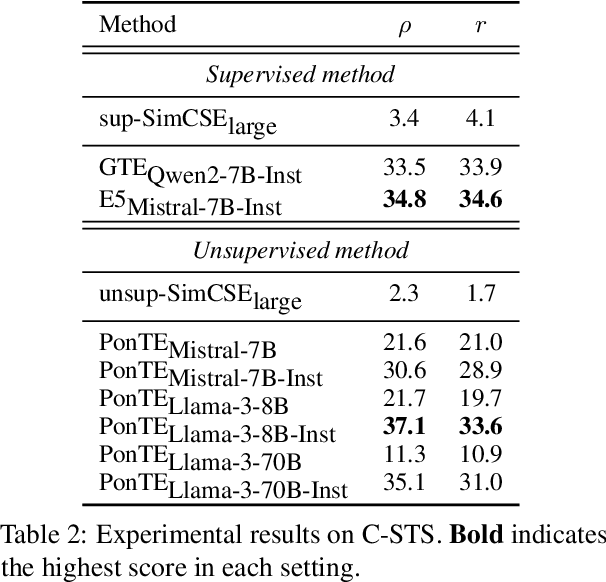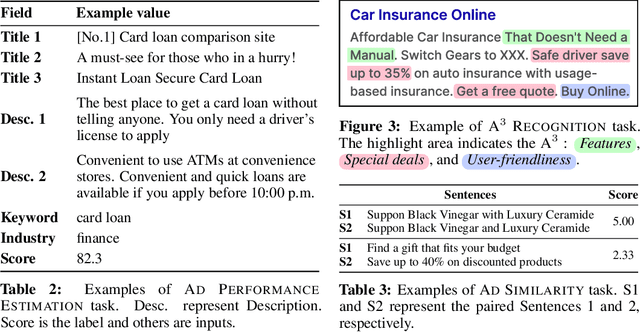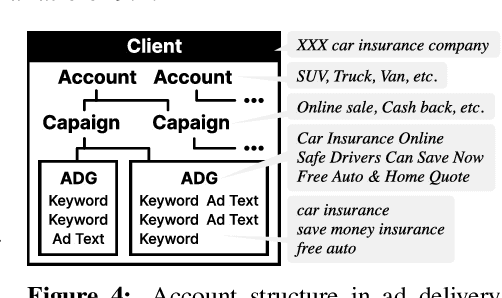Peinan Zhang
AdParaphrase v2.0: Generating Attractive Ad Texts Using a Preference-Annotated Paraphrase Dataset
May 27, 2025Abstract:Identifying factors that make ad text attractive is essential for advertising success. This study proposes AdParaphrase v2.0, a dataset for ad text paraphrasing, containing human preference data, to enable the analysis of the linguistic factors and to support the development of methods for generating attractive ad texts. Compared with v1.0, this dataset is 20 times larger, comprising 16,460 ad text paraphrase pairs, each annotated with preference data from ten evaluators, thereby enabling a more comprehensive and reliable analysis. Through the experiments, we identified multiple linguistic features of engaging ad texts that were not observed in v1.0 and explored various methods for generating attractive ad texts. Furthermore, our analysis demonstrated the relationships between human preference and ad performance, and highlighted the potential of reference-free metrics based on large language models for evaluating ad text attractiveness. The dataset is publicly available at: https://github.com/CyberAgentAILab/AdParaphrase-v2.0.
Out-of-the-Box Conditional Text Embeddings from Large Language Models
Apr 23, 2025



Abstract:Conditional text embedding is a proposed representation that captures the shift in perspective on texts when conditioned on a specific aspect. Previous methods have relied on extensive training data for fine-tuning models, leading to challenges in terms of labor and resource costs. We propose PonTE, a novel unsupervised conditional text embedding method that leverages a causal large language model and a conditional prompt. Through experiments on conditional semantic text similarity and text clustering, we demonstrate that PonTE can generate useful conditional text embeddings and achieve performance comparable to supervised methods without fine-tuning. We also show the interpretability of text embeddings with PonTE by analyzing word generation following prompts and embedding visualization.
AdParaphrase: Paraphrase Dataset for Analyzing Linguistic Features toward Generating Attractive Ad Texts
Feb 07, 2025



Abstract:Effective linguistic choices that attract potential customers play crucial roles in advertising success. This study aims to explore the linguistic features of ad texts that influence human preferences. Although the creation of attractive ad texts is an active area of research, progress in understanding the specific linguistic features that affect attractiveness is hindered by several obstacles. First, human preferences are complex and influenced by multiple factors, including their content, such as brand names, and their linguistic styles, making analysis challenging. Second, publicly available ad text datasets that include human preferences are lacking, such as ad performance metrics and human feedback, which reflect people's interests. To address these problems, we present AdParaphrase, a paraphrase dataset that contains human preferences for pairs of ad texts that are semantically equivalent but differ in terms of wording and style. This dataset allows for preference analysis that focuses on the differences in linguistic features. Our analysis revealed that ad texts preferred by human judges have higher fluency, longer length, more nouns, and use of bracket symbols. Furthermore, we demonstrate that an ad text-generation model that considers these findings significantly improves the attractiveness of a given text. The dataset is publicly available at: https://github.com/CyberAgentAILab/AdParaphrase.
LCTG Bench: LLM Controlled Text Generation Benchmark
Jan 27, 2025



Abstract:The rise of large language models (LLMs) has led to more diverse and higher-quality machine-generated text. However, their high expressive power makes it difficult to control outputs based on specific business instructions. In response, benchmarks focusing on the controllability of LLMs have been developed, but several issues remain: (1) They primarily cover major languages like English and Chinese, neglecting low-resource languages like Japanese; (2) Current benchmarks employ task-specific evaluation metrics, lacking a unified framework for selecting models based on controllability across different use cases. To address these challenges, this research introduces LCTG Bench, the first Japanese benchmark for evaluating the controllability of LLMs. LCTG Bench provides a unified framework for assessing control performance, enabling users to select the most suitable model for their use cases based on controllability. By evaluating nine diverse Japanese-specific and multilingual LLMs like GPT-4, we highlight the current state and challenges of controllability in Japanese LLMs and reveal the significant gap between multilingual models and Japanese-specific models.
FaithCAMERA: Construction of a Faithful Dataset for Ad Text Generation
Oct 04, 2024



Abstract:In ad text generation (ATG), desirable ad text is both faithful and informative. That is, it should be faithful to the input document, while at the same time containing important information that appeals to potential customers. The existing evaluation data, CAMERA (arXiv:2309.12030), is suitable for evaluating informativeness, as it consists of reference ad texts created by ad creators. However, these references often include information unfaithful to the input, which is a notable obstacle in promoting ATG research. In this study, we collaborate with in-house ad creators to refine the CAMERA references and develop an alternative ATG evaluation dataset called FaithCAMERA, in which the faithfulness of references is guaranteed. Using FaithCAMERA, we can evaluate how well existing methods for improving faithfulness can generate informative ad text while maintaining faithfulness. Our experiments show that removing training data that contains unfaithful entities improves the faithfulness and informativeness at the entity level, but decreases both at the sentence level. This result suggests that for future ATG research, it is essential not only to scale the training data but also to ensure their faithfulness. Our dataset will be publicly available.
AdTEC: A Unified Benchmark for Evaluating Text Quality in Search Engine Advertising
Aug 12, 2024



Abstract:With the increase in the more fluent ad texts automatically created by natural language generation technology, it is in the high demand to verify the quality of these creatives in a real-world setting. We propose AdTEC, the first public benchmark to evaluate ad texts in multiple aspects from the perspective of practical advertising operations. Our contributions are: (i) Defining five tasks for evaluating the quality of ad texts and building a dataset based on the actual operational experience of advertising agencies, which is typically kept in-house. (ii) Validating the performance of existing pre-trained language models (PLMs) and human evaluators on the dataset. (iii) Analyzing the characteristics and providing challenges of the benchmark. The results show that while PLMs have already reached the practical usage level in several tasks, human still outperforms in certain domains, implying that there is significant room for improvement in such area.
Not Eliminate but Aggregate: Post-Hoc Control over Mixture-of-Experts to Address Shortcut Shifts in Natural Language Understanding
Jun 17, 2024Abstract:Recent models for natural language understanding are inclined to exploit simple patterns in datasets, commonly known as shortcuts. These shortcuts hinge on spurious correlations between labels and latent features existing in the training data. At inference time, shortcut-dependent models are likely to generate erroneous predictions under distribution shifts, particularly when some latent features are no longer correlated with the labels. To avoid this, previous studies have trained models to eliminate the reliance on shortcuts. In this study, we explore a different direction: pessimistically aggregating the predictions of a mixture-of-experts, assuming each expert captures relatively different latent features. The experimental results demonstrate that our post-hoc control over the experts significantly enhances the model's robustness to the distribution shift in shortcuts. Besides, we show that our approach has some practical advantages. We also analyze our model and provide results to support the assumption.
Cross-lingual Transfer or Machine Translation? On Data Augmentation for Monolingual Semantic Textual Similarity
Mar 08, 2024Abstract:Learning better sentence embeddings leads to improved performance for natural language understanding tasks including semantic textual similarity (STS) and natural language inference (NLI). As prior studies leverage large-scale labeled NLI datasets for fine-tuning masked language models to yield sentence embeddings, task performance for languages other than English is often left behind. In this study, we directly compared two data augmentation techniques as potential solutions for monolingual STS: (a) cross-lingual transfer that exploits English resources alone as training data to yield non-English sentence embeddings as zero-shot inference, and (b) machine translation that coverts English data into pseudo non-English training data in advance. In our experiments on monolingual STS in Japanese and Korean, we find that the two data techniques yield performance on par. Rather, we find a superiority of the Wikipedia domain over the NLI domain for these languages, in contrast to prior studies that focused on NLI as training data. Combining our findings, we demonstrate that the cross-lingual transfer of Wikipedia data exhibits improved performance, and that native Wikipedia data can further improve performance for monolingual STS.
Generating Diverse and High-Quality Texts by Minimum Bayes Risk Decoding
Jan 10, 2024



Abstract:One of the most important challenges in text generation systems is to produce outputs that are not only correct but also diverse. Recently, Minimum Bayes-Risk (MBR) decoding has gained prominence for generating sentences of the highest quality among the decoding algorithms. However, existing algorithms proposed for generating diverse outputs are predominantly based on beam search or random sampling, thus their output quality is capped by these underlying methods. In this paper, we investigate an alternative approach -- we develop diversity-promoting decoding algorithms by enforcing diversity objectives to MBR decoding. We propose two variants of MBR, Diverse MBR (DMBR) and $k$-medoids MBR (KMBR), methods to generate a set of sentences with high quality and diversity. We evaluate DMBR and KMBR on a variety of directed text generation tasks using encoder-decoder models and a large language model with prompting. The experimental results show that the proposed method achieves a better trade-off than the diverse beam search and sampling algorithms.
CAMERA: A Multimodal Dataset and Benchmark for Ad Text Generation
Sep 21, 2023



Abstract:In response to the limitations of manual online ad production, significant research has been conducted in the field of automatic ad text generation (ATG). However, comparing different methods has been challenging because of the lack of benchmarks encompassing the entire field and the absence of well-defined problem sets with clear model inputs and outputs. To address these challenges, this paper aims to advance the field of ATG by introducing a redesigned task and constructing a benchmark. Specifically, we defined ATG as a cross-application task encompassing various aspects of the Internet advertising. As part of our contribution, we propose a first benchmark dataset, CA Multimodal Evaluation for Ad Text GeneRAtion (CAMERA), carefully designed for ATG to be able to leverage multi-modal information and conduct an industry-wise evaluation. Furthermore, we demonstrate the usefulness of our proposed benchmark through evaluation experiments using multiple baseline models, which vary in terms of the type of pre-trained language model used and the incorporation of multi-modal information. We also discuss the current state of the task and the future challenges.
 Add to Chrome
Add to Chrome Add to Firefox
Add to Firefox Add to Edge
Add to Edge